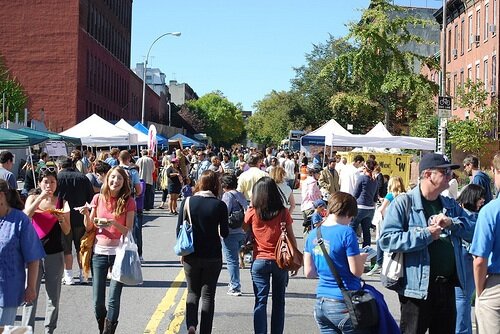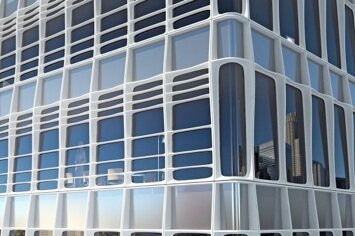New Build vs Retrofit - Two Views on Sustainable Building
The Fall brought two approaches to sustainable building design to New York City; one sponsored by the AIANY chapter’s Center for Architecture, focused on new construction, and the second combining aspects of new build with retrofit techniques was organized by GreenHomeNYC and took place right here in our own Carroll Gardens.
On October 2nd, GreenHomeNYC and local business and community groups sponsored a “sustainable” block party and environmental fair on 3rd street called a DIY Green Block Party. The fair included fifty-five informational booths and open house tours of the Hudson Companies’ new Third + Bond LEED (Leadership in Energy Efficiency Design) certified condominium. The block party featured workshops on how to build a green roof, conduct an energy audit, and capture and reuse rainwater run-off among other topics. GreenHome planned the festival so to coincide with the American Solar Energy Society’s national solar tour.
“Cities generally, and New York City specifically, are some of the most sustainable places per capita you can find, and a lot of that is out of necessity,” said Nevala-Lee, a GreenHomeNYC volunteer, adding that New Yorkers “may not be making the best or the most environmentally responsible decisions, but they are at least aware” of the financial and environmental costs of their choices.
Exhibitors focused on energy conservation topics such as green roofs - Future Green Studio; passive energy techniques - Trees New York; solar collectors - Solar One and Solar Energy; wind power - Green Mountain Energy, as well as sustainable community design advocates such as Stormwater Infrastructure Matters Coalition and the Lower East Side Ecology Center.
There were also booths focusing on traditional energy sources and energy audits offered by NYSERDA, National Grid and Con Edison.
Other booths included interesting groups like Attiya Anthony’s Tri-State Biodiesel, a company which collects waste cooking oil from restaurants, processing it and converting it to biodiesel, which they in turn sell to moving companies like Movers Not Shakers, which also had a booth at the fair.
Mobile Libris sponsored a table focused on eco-conscious books including conservation titles like Rachel Carson’s Silent Spring and how-to manuals like The Lazy Environmentalist by Josh Dorfman.
The Gowanus Canal Conservancy had a booth and conducted canoe tours of the canal throughout the day. The GCCDC also had a booth featuring David Lee and the work of his Clemson University design studio for a new GCCDC headquarters and waterfront science center S+9.
All in all the block party was a great resource for local homeowners large (condo and co-op boards) and small (single family townhouses) to learn about ways to help make our neighborhood greener and more sustainable.
A complete list of booth vendors can be found here.
In contrast this fall, the Center for Architecture opened its first exhibition focused on building technology, Innovate:Integrate. The exhibit explored new technologies and new building techniques for improving the built environment in New York City. The hope is that promoting these kind of innovations for construction and design will help architects and developers reach the environmental and economic goals needed to make a sustainable New York for the 21st century.
Innovate:Integrate contained full scale models, videos, technical drawings, and hands-on samples some which related to “integration” - that is retrofits to existing buildings, but primarily focused on “innovate” - that is new construction.
The innovation portion of the exhibit showcased material advancements, energy harvesting in the form of solar panels and wind turbines, and daylight optimization. The show also featured work of the six finalist entries of AIANY’s “Open Call for Innovative Curtain-Wall Design.”
The highest honor was presented to Peter Arbour, Assoc. AIA, and RFR Consulting Engineers for their Liquid Wall; for the exhibition a prototype of the wall was constructed and will be installed in the Center for Architecture’s double-height front window.
The Integrated Concentrating Solar Façade System, by HeliOptix and developed at Rensselaer Polytechnic Institute, won the Merit award. The other finalists who were featured in the exhibition included the Climate Camouflage, also by CASE; F.A.T. (Fluent Adipose Tectonic), by form-ula; the Self-Shading Curtain Wall at Kuwait University’s College of Education by Perkins+Will in joint venture with Dar Al-Handasah; and HelioTrace Façade system, by SOM, Permastellisa, and the Adaptive Building Initiative.
While the integration portion of the show was not as compelling in making the archiment for building retrofits, it did gesture toward several of the energy saving, sustainable techniques featured at GreenHomeNYC’s block party: solar energy, wind energy and green roofs.
In general both forums reveal a growing interest in sustainable design on the part of both developers and individual home owners.


